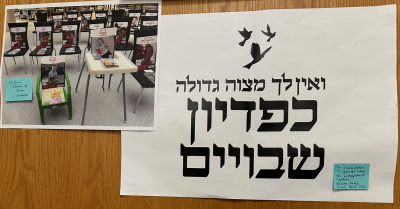"So that we may not see such horrors again in our lifetime."

Marc Brettler, Bernice and Morton Lerner Distinguished Professor in Judaic Studies, gave a reflection during the October 7 memorial in remembrance of the victims, and the hostages.
"What an awful year it has been. I remember as if it were yesterday being awakened at 2 AM, exactly a year ago by my partner who lives in Jerusalem to the words: “There is a war.” I remember watching Israel’s channel 12 and seeing the death toll mount on the bottom of the screen—me’ah harugim, ma’tayim harugim, and it climbing and climbing until it reached ’elef harugim—one thousand killed—and kept going. I remember hearing that Nir Forti, the son of an Israeli Bible colleague of mine who was at the rave, was missing; he was identified only weeks later because his body was burned beyond recognition. I remember hearing on Oct 8 that Deborah and Shlomi Matias, the daughter and son-in-law of my former Brandeis colleague Ilan Troen, were killed in Kibbutz Hollit while successfully protecting their 16 year-old son Rotem from terrorist gunfire. I remember my friends who lived in Kiryat Shmona, who along with over 50,000 others, still cannot return to their homes in the North. I remember hearing this February that David Schwartz, son of my friend, Bible Professor Sarah Schwartz, was killed fighting in Gaza. I remember the days during my leave in Jerusalem when I researched in the sifriyah le’umit, the National Library, and passed the exhibit there of chairs—one for each hostage, each with a book related to the particular hostage’s interests, including a highchair and a small chair for the two Bibas children. And differently, I also remember the hate and the indifference and lack of allyship that so many of us have experienced over the last year from some of our “friends.”
But I also remember standing nearby, in the Bryan Plaza, almost a year ago, as the Duke community came together to pray, sing, grieve, and to comfort one another. And what I find most encouraging about today’s gathering is not the number of you who are here—though that too is offering me some solace—but the diversity of people, especially from disparate Jewish organizations.
This year we are commemorating the horrors of the Oct 7 massacre and its aftermath in the midst of the High Holiday season. The High Holiday liturgy contains the phrase: ויעשו כולם אגודה אחת לעשות רצונך בלבב שלם, “and may they—the Jewish people—be formed into a single group, to fulfill your will with a full heart”—and it suggests that only when this happens, kapparah, forgiveness, is possible.
The phrase aggudah achat, “one group,” is referring to two rabbinic midrashim, biblical expositions. One is on Deut 14.1, בָּנִ֣ים אַתֶּ֔ם לַֽיהוָ֖ה אֱלֹהֵיכֶ֑ם, “you are God’s children,” which continues לֹ֣א תִתְגֹּֽדְד֗וּ, which in context means “do not intentionally lacerate/cut yourselves” as a rite of mourning. In several places the rabbis playfully interpret lo’ titgodedu as לא תעשו אגודות אגודות, “do not form yourselves into different factions” —the word for “faction,” aggudah, sounds like the word “lacerate,” titgodedu. Factionalizing leads to alienation—when Jews factionalize, the rabbis suggest, they are no longer God’s children.
BUT—and for me this is a crucial but—this does not mean that we must be single-minded. The second midrash makes this clear. It concerns Sukkot, the upcoming fall harvest festival, when we take a lulav, a palm frond, an etrog, a lemon-like citron, and two bunches of other branches, and shake them. What might these specific four species symbolize?
A midrash in Leviticus Rabbah reads:
The four species are likened to different categories in the Jewish people. The etrog, which has both taste and smell, is likened to those who study Torah and do mitzvot—good deeds. The palm branch, which has taste, but no smell, is likened to those who have only Torah study. The myrtle, which has smell but no taste, is likened to those who have only mitzvot—commandments. The willow, which has neither taste nor smell, is likened to those who are without Torah study and without mitzvot. And what does God do with each of these groups? He cannot make them perish, so the Holy one says: “let them all be bound into a single bundle (אגודה אחת) so they will atone one for the other.”
Note—the etrog, symbolizing both good deeds, mitzvot and Torah study cannot simply atone for the others. It is only when the four very different plants come together as differentiated species that atonement is successful.
That is why, even in my terrible sadness and grief, I find this gathering so important, for it shows that despite such different religious and political perspectives, we can join together—at least to remember and to grieve. This event shows that we are beginning to trust one another, and we must build upon that trust.
I have been to Israel four times since October 7, for over 4 months, and I am traveling there again in a few days. I brought back from one of my trips a sign that reads: ואין לְךָ מִצְוָה גדולה כְּפִדְיוֹן שְׁבוּיִים —“there is no commandment that is as significant as ransoming hostages,” and hung it on my office door. It is still there. I have affixed to it my photo from the National Library of Israel of the small chair with a picture of the then 4 year old Ariel Bibas, with his book ’Imma Ve-’ani—Mommy and Me, and the highchair with a picture of 8 month old Kfir Bibas, with the board book by the famous Israeli poet Leah Goldberg, about a dog who ran away, but found his way home: Ayeh Pluto—Where is Pluto?
I end with two hopes: that I will very soon be able to remove these signs as the dozens of live hostages come home, and that the banding together created by the horrors of Oct 7, 2023 created will continue, so that we may not see such horrors again our lifetime."
